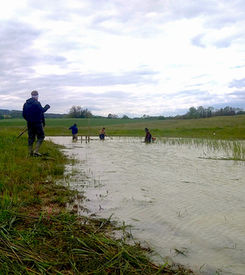Maintenance & Neophytes Gravel Pit Weiach
Realized:
2024
carried out by:
Naturnetz Nordostschweiz
Realized:
Weiach, Switzerland
The Weiach gravel pit is located in the north of the canton of Zurich, not far from the Rhine, which forms the border with Germany. At 335 m above sea level, it is at the lowest point in the canton. The gravel pit has been operated by Weiacher Kies AG since 1962. Gravel mining takes place in stages. The gravelly, stony soils on the areas that have already been mined are lying fallow. Replacement habitats for rare animal and plant species are being created on them. In consultation with the canton (nature conservation department) and the municipality, around 23 hectares of ecological compensation areas were created on the entire Weiacher Kies AG site. These include shallow water ponds, dry sites, hedges and lean meadows. The latter has become very rare in the canton of Zurich and is hardly found anywhere outside the Weiach gravel pit.
The canton of Zurich bears a special responsibility for, among other things, Weissenburg cinquefoil ( Potentilla leucopolitana ), goat's-bellied tongue ( Himantoglossum hircinum ) and pasqueflower ( Pulsatilla vulgaris ). The dry, warm climate and sparse vegetation also encourage the occurrence of various species of locust. For example, the rare blue-winged grasshopper ( Oedipoda caerulescens) is found here. Natterjack toads ( Bufo calamita ) frolic in the shallow pools and the black mortar bee ( Megachile parietina ) lives on the sun-exposed slopes of the pit. This species of bee depends on sainfoin and bird's-foot trefoil stands. The little ringed plover ( Charadrius dubius ) also occasionally breeds in the adjacent fields and gravel areas.
On behalf of the Nature Conservation Department (Canton of Zurich), the eco-office Topos Marti & Müller AG coordinates and supervises the neophytes and maintenance work, some of which is carried out by the nature network. This year (2019), the focus was on combating neophytes and removing woody plants and blackberries from the barren areas of the gravel pit. The aim is to prevent the valuable open areas (gravel areas & meadows) from becoming overgrown with forest and to prevent rare plant species from being displaced by neophytes. In addition, a forest bay was mowed to encourage butterflies and the shallow water pools were mowed using underwater mowers. Barren bank vegetation encourages the appearance of natterjack toads, which depend on warm and vegetation-poor areas. The removed neophytes (goldenrod, fleabane, buddleia, evening primrose, etc.) were packed in cardboard bags and stored. The bags were then picked up and disposed of by a local farmer.
We look forward to continuing our work next year to preserve this exciting habitat.







